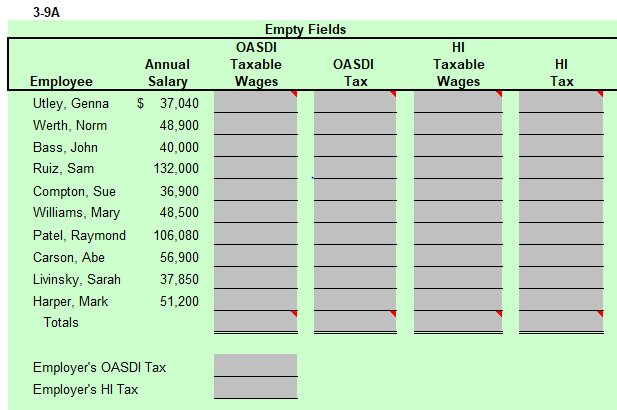Content
- How to Prepare an Accounts Payable Aging Report: 5 Quick Steps
- What is the Difference Between Accounts Payable and Trade Payables?
- Collect Cash on a Credit Sale
- Understanding Accounts Payable (AP) With Examples and How to Record AP
- What is the Relationship Between Cash Flow and Accounts Payable?
- Accounts receivable

An accounts payable manager coordinates the team and implements operational strategies to ensure efficient AP team cooperation. Depending on the company’s size, there are designated specialists or a separate accounts receivable department to navigate through the so-called order-to-cash cycle. Company cards, local & overseas invoice payment, approval-based spending and accounting automation. An accounts payable aging report is crucial in managing business finances.
- Debits and credits in an accounting journal will always appear in columns next to one another.
- Although some people use the phrases “accounts payable” and “trade payables” interchangeably, the phrases refer to similar but slightly different situations.
- Increasing DPO and decreasing DSO both boost your working capital and can increase cash flows.
- Accounts payables and receivables likely make up the bulk of your current liabilities and assets, so effectively managing them is key to having sufficient working capital.
- This is because items that are sent back to the provider cut down on the responsibility linked with such items, supposing that the supplier would accept returns.
The account payable is a liability account used to track the amount of money a company owes to its vendors or other outside parties. The suppliers are independent persons willing to give the company credit to purchase the raw materials. Any growth in the account payable account would be recorded https://business-accounting.net/ as the credit in the account payables. In contrast, any drop in the account payable account would be reflected as a debit in the account payables. It may be helpful to note that an account payable at one company is an account receivable for the vendor that issued the sales invoice.
How to Prepare an Accounts Payable Aging Report: 5 Quick Steps
Posting that data to our system keeps payment smooth and makes the data available when you need it. Each invoice is processed using the standards and procedures you’ve negotiated with each vendor. Then the invoices are routed through the responsible parties within your organization for approval so that payment can be issued. Whether we’re talking about accounts receivable or payable, management is time-sensitive and, at the same time, requires meticulous processing of documents.
- When looking at basic examples of accounts payable, you will often be referencing a purchase or vendor invoice.
- Part of the entry would involve tagging the correct supplier on the transactions.
- However, this flexibility to pay later must be weighed against the ongoing relationships the company has with its vendors.
- This signifies a reduction in the amount owed to service providers by the company.
- When you pay off the invoice, the amount of money you owe decreases .
- For instance, they might extend a credit line to certain customers that receive invoices periodically, rather than make separate payments for every transaction.
With accounts payable managed and processed in accordance with clear guidelines, managers can streamline document processing and help ensure the payment deadlines are met. A payment processing specialist ensures invoices are approved by the relevant responsible people and paid on time. Accounts payable include all short-term obligations, such as office supplies and equipment, power and fuel, software licenses, other maintenance services, etc.
What is the Difference Between Accounts Payable and Trade Payables?
Companies should also be aware of the risks that can arise as a result of conflicts of interest, for example if an accounts payable employee has an undeclared interest in one of the company’s suppliers. Recording and tracking your accounts payables and receivables add up to a lot of time each day — time you could be using to grow your business. If you’re interested in letting experts manage your A/P and A/R so you can do what you do best, contact CFO Hub today to schedule your free, no-obligation consultation. Accounts payables and receivables likely make up the bulk of your current liabilities and assets, so effectively managing them is key to having sufficient working capital. In fact, the accuracy of everything from your net income to your accounting ratios depends on properly entering debits and credits.
Euronet Reports Fourth Quarter and Full Year Financial Results – InvestorsObserver
Euronet Reports Fourth Quarter and Full Year Financial Results.
Posted: Wed, 08 Feb 2023 02:41:30 GMT [source]
Accounts receivable, AR, or “receivables,”are claims for payment that a company expects to receive upon selling goods or services on credit. Receivables are relevant for sellers who extend credit lines to their customers and expect payments for goods sold or services rendered. Each team can modify the workflow depending on their company’s needs.
Collect Cash on a Credit Sale
Accounts payable is recorded on the balance sheet under current liabilities. The journal entry is a credit to Accounts Payable (to increase it, since Is Accounts Payable a Credit or Debit it’s a liability) and a debit an expense account. If you bought a capitalizable asset on credit, then an asset account would be debited instead.
Accounts receivable is the money owed to the company, mostly by its clients and customers. The vendor or supplier usually issues an invoice immediately upon making a purchase. They can send the invoice electronically or through a physical copy. The accounts payable department receives the vendor invoice and notes it for review. It is best to record transactions under accounts payable as soon as the invoice or voucher arrives.
You may be failing to collect on your receivables in a timely fashion, or you could have extra cash that you could invest in your business for growth. In some cases — such as with expensive equipment purchases from vendors — you may record a note payable instead of an account payable. The general ledger then puts amounts into the proper asset, liability, and equity accounts. Xero offers double-entry accounting, as well as the option to enter journal entries. Reporting options are also good in Xero, and the application offers integration with more than 700 third-party apps, which can be incredibly useful for small businesses on a budget.

Companies typically expect to close both APs and ARs within several days to several months. To do so efficiently and on-time, more and more businesses choose to implement automation tools.
Understanding Accounts Payable (AP) With Examples and How to Record AP
Sometimes, this involves borrowing funds as payment for supplies and services. Let us look at some examples of how the utilities payable are practically recorded. Equity accounts record the claims of the owners of the business/entity to the assets of that business/entity.Capital, retained earnings, drawings, common stock, accumulated funds, etc. Examples include trust accounts, debenture, mortgage loans and more.
- Then, multiply the results by the number of days for the corresponding period (month, quarter, year, etc.).
- The process of using debits and credits creates a ledger format that resembles the letter “T”.
- This is accounts payable, and will normally have a credit period of 30 days or more.
- Having sufficient operating procedures is extremely important to reduce improper payments, ensure regulatory compliance, and reduce the risk of human error.
- The question above does confuse some due to the terminology used in accounting.
In turn, they’ll see a significant acceleration of transaction processing and a decrease in the average cost of doing so. Debited amounts represent assets, while credited amounts represent liabilities. In the end, after balancing debit and credit, we should always get zero – the sum of all debits should equal the sum of all credits.
